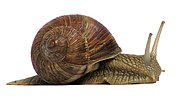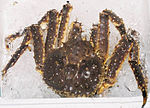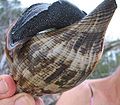 | Hemocyanins (also spelled haemocyanins and abbreviated Hc) are proteins that transport oxygen throughout the bodies of some invertebrate animals. These... 24 KB (2,619 words) - 21:28, 21 April 2024 |
Respiratory pigment (section Hemocyanin) There are four major classifications of respiratory pigment: hemoglobin, hemocyanin, erythrocruorin–chlorocruorin, and hemerythrin. The heme-containing globin... 10 KB (1,054 words) - 11:17, 18 August 2023 |
blue blood may refer to: Hemolymph, circulatory fluid colored blue by hemocyanin, a respiratory protein evident in most molluscs and some arthropods Nobility... 2 KB (277 words) - 20:14, 15 December 2023 |
 | have a pallial lung. The respiratory protein in almost all gastropods is hemocyanin, but one freshwater pulmonate family, the Planorbidae, have hemoglobin... 48 KB (5,023 words) - 03:16, 7 April 2024 |
continua Hyperelastosis cutis or hereditary equine regional dermal asthenia Hemocyanin, a metalloprotein abbreviated Hc HC smoke, a US military designation for... 2 KB (262 words) - 17:07, 12 January 2024 |
 | anaerobic conditions. Branchial hearts also appear to be involved in hemocyanin synthesis. Each branchial heart is directly connected to a branchial heart... 3 KB (317 words) - 15:10, 7 November 2023 |
 | Megathura crenulata (section Keyhole limpet hemocyanin) hemoglobin, the hemocyanin is not bound to cells but is simply dissolved in the hemolymph, the fluid part of the blood. Keyhole limpet hemocyanin from Megathura... 6 KB (563 words) - 19:24, 19 January 2024 |
the terms immunogen and antigen were not distinguished. Keyhole limpet hemocyanin It is copper-containing respiratory protein, isolated from keyhole limpets... 7 KB (826 words) - 03:24, 24 November 2023 |
 | skeleton. The blood of these molluscs contains the respiratory pigment hemocyanin as an oxygen-carrier. The heart consists of one or more pairs of atria... 93 KB (9,438 words) - 10:13, 14 April 2024 |
oxygen-carrying proteins such as myoglobin, hemoglobin, hemerythrin, and hemocyanin. Several transition metals form complexes with O2, and many of these complexes... 10 KB (1,080 words) - 11:07, 20 January 2024 |
to: Green Blood (manga), a Japanese manga series by Masasumi Kakizaki Hemocyanin, a copper-based system of transporting oxygen in blood found in many molluscs... 627 bytes (113 words) - 20:27, 22 September 2021 |
worms. Hemocyanin is homologous to the phenol oxidases (e.g. tyrosinase) since both enzymes sharing type copper active site coordination. Hemocyanin also... 27 KB (3,072 words) - 22:54, 27 September 2023 |
 | water using a plastron or blood gill Storage of oxygen in hemoglobin and hemocyanin molecules in hemolymph Taking oxygen from surface via breathing tubes... 8 KB (843 words) - 03:22, 5 September 2023 |
 | the inner wall of the carapace. In addition, the respiratory protein hemocyanin has been found in the two orders Myodocopida and Platycopida. Nitrogenous... 35 KB (3,684 words) - 20:43, 27 April 2024 |
allow the hemocyanin to continue to function efficiently. The Dungeness crab, Cancer magister, relies on the magnesium ion (Mg2+) for its hemocyanin oxygen... 6 KB (696 words) - 19:45, 8 March 2024 |















